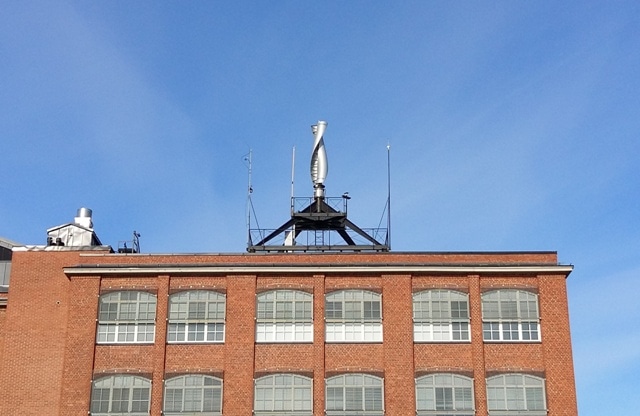May 23 2016
Finnish invention, a vertical axis Savonius wind turbine can be further improved shows a new study from the University of Vaasa.
 One modification of Savonius wind turbine is Windside wind turbine.
One modification of Savonius wind turbine is Windside wind turbine.
Due to the mechanical modification of the rotor the power coefficient was shown to be increased by around 8 percent (2% units). The power coefficient is the ratio of the power extracted by the rotor to the available kinetic power in the air flow.
According to doctoral thesis of Svetlana Marmutova, University of Vaasa, the variation of the power coefficient under gusty wind conditions depends on the level of gustiness: the higher the gustiness the more stable is power coefficient.
“It is a good feature since wind in cities is gusty and stable rotor operation is favorable”, says Marmutova.
Marmutova also studied the effect a Savonius turbine can have on the radar operation.
Low noise level is an advantage
Savonius wind rotor was invented by Finnish marine engineer Sigurd Savonius in early twenties of the last century. Initially it was proposed by Savonius to use the rotor for sailing, water pumping, ventilation and power generation using air and water as well. Nowadays Savonius wind turbine has many modifications.
Generally, wind turbines can be classified as vertical axis (VAWT) and horizontal axis (HAWT) depending on the axis of rotation. An example of a horizontal axis wind turbine the reader can see all over the world in wind parks.
Among the advantages of a vertical axis Savonius wind turbine are low noise level, the ability to operate with low wind speeds and relative independence on the wind direction and simplicity of maintenance and manufacture of the turbine. Basically the simple rotor can be obtained by cutting any cylindrically shaped object and moving the parts sideways along the cutting plane. However, the rotor has low power coefficient and power output in comparison to HAWTs.
“Nevertheless, Savonius wind turbine can provide a good solution for wind power generation in cities due to its size and less sensitivity to the changes in wind speed and direction in comparison to HAWTs”, says Marmutova.
In the frame of the study, conducted in the University of Vaasa, some aspects of a Savonius wind turbine operation in urban areas were considered. The proposed modification adds a plane in the center of a rotor, which decreases the pressure behind the advancing blade thus increasing the lift force. Thus, a Savonius rotor is drag and lift device. The advancing blade is the blade which moves in the direction of the incoming wind.
Next, it must be taken into account that a Savonius rotor may affect the radar operation. Basically the radar operation is based on the analysis of sent and received signals: thus the presence and the distance to the target can be obtained. However, any objects on the signal way cause sort of “blind zone” for the radar. The size of this zone depends, evidently on the object dimensions and material. These results were obtained using the computational fluid dynamic (CFD) analysis and Ansys Fluent® and Comsol Multiphysics® applications. Statistical analysis of the wind regime was done using the wind speed measurements performed in the University of Vaasa campus area.